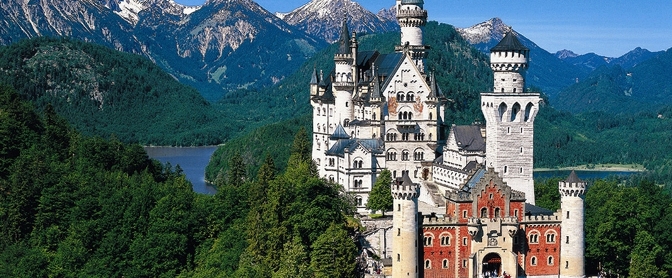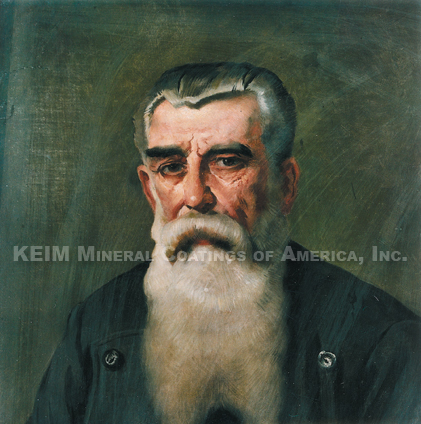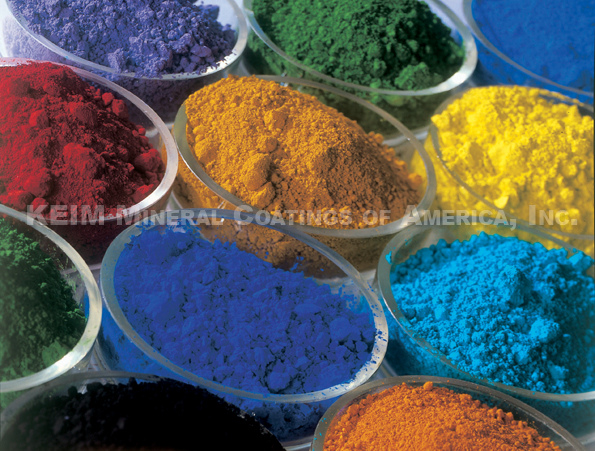
KEIM Silicate Paints - Unique by more than 130 years
… ecological, economical, social
KEIM silicate mineral coatings are a Bavarian invention with their roots deep in the region’s heritage. They are synonymous with the technical refinement and high quality that is typical in products originating from this area of Alps, kings and castles.
 The scientist Adolf Wilhelm Keim, the inventor of mineral paints, successfully combined water glass (potassium silicate solution) with inorganic color pigments to produce a coating that both penetrates and chemically reacts with mineral substrates. Unlike organic paints that merely form a skin, KEIM coatings become an integral part of the surface.
The scientist Adolf Wilhelm Keim, the inventor of mineral paints, successfully combined water glass (potassium silicate solution) with inorganic color pigments to produce a coating that both penetrates and chemically reacts with mineral substrates. Unlike organic paints that merely form a skin, KEIM coatings become an integral part of the surface.
This high quality silicate coating system offers performance, durability, protection, and color fastness that is yet unsurpassed. Buildings decorated with KEIM in the 19th century are still in excellent condition today. Such examples include some of the oldest and most precious early Renaissance style facades of the Weisser Adler house in Stein am Rhein and the Town Hall in Schwyz, Switzerland that were redecorated in 1891, together with facades in Oslo (1895) and in Traunstein, Germany (1891).
Potassium silicate has been known since The Middle Ages when it was termed Liquor Silicium but was not exploited due to a lack of production know how and end uses. In 1768, Johann Wolfgang von Goethe, the prolific German poet, and scholar, commented upon his own experiments, “what most occupied my spirit for a long while was the so called Liquor Silicium which is obtained if pure quartz sand is melted with an adequate proportion of alkali, giving rise to a transparent glass which melts in air yielding a beautiful clear liquid...”. However, Goethe was unable to translate his thoughts into any practical uses.
 The catalyst for Adolf Keim’s development work was King Ludwig I of Bavaria. This monarch had a great passion for the arts. He longed to have examples of fine Italian lime frescoes in his own kingdom but the harsh climate north of the Alps destroyed them within a short time. He appealed to his Bavarian scientists to develop a paint that would offer the appearance of lime fresco art yet resist the harsh weather.
The catalyst for Adolf Keim’s development work was King Ludwig I of Bavaria. This monarch had a great passion for the arts. He longed to have examples of fine Italian lime frescoes in his own kingdom but the harsh climate north of the Alps destroyed them within a short time. He appealed to his Bavarian scientists to develop a paint that would offer the appearance of lime fresco art yet resist the harsh weather.
The unique solution to these requirements was embodied in Keim’s invention - a liquid silicate coating that chemically binds both the color pigment and the applied surface.
KEIM’s classic mineral coating enabled him to build his position as the leading manufacturer of mineral coatings for facade decoration through research-based improvements to product characteristics and a thorough knowledge of substrates.
Today’s environmental awareness has led to increasing levels of demand for environmentally compatible paints which are durable and of high quality. KEIM has responded by providing a wide range of mineral based products, anchoring its position as the leading supplier of silicate mineral paints in the world.
Milestones
1878 — the first generation: KEIM Purkristalat. Some 130 years ago, KEIM developed the first practical silicate paint. It consists of a powder component with inorganic pigments and mineral extenders with a liquid component, the potassium water glass binder.
1962 — the second generation: KEIM Granital. 1962 saw the introduction of KEIM Granital, the second generation silicate paint. Granital’s advantage resides in its single-component formulation which makes it considerably easier to handle and increases reliability of application.
2002 — the third generation: KEIM Soldalit. In 2002, what is now the third generation of silicate paints revolutionized the exterior coatings market. KEIM Soldalit sol silicate paint is based on an entirely new binder development and opens up entirely new areas of application for silicate paints.